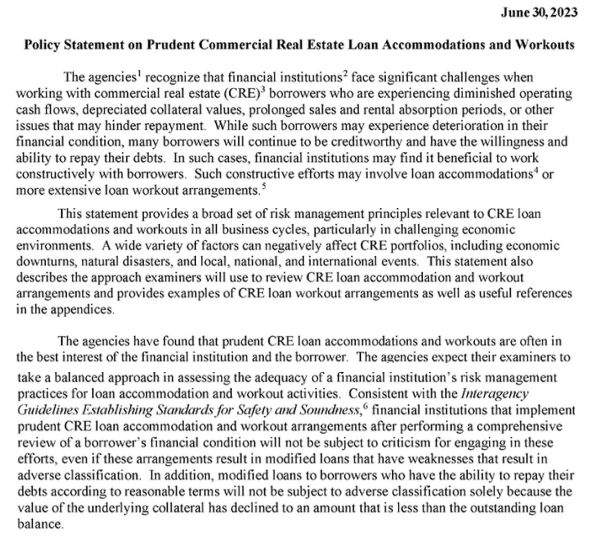A little over two months ago, the federal banking authorities (Feds) issued a new Policy Statement, a re-vamp and expansion of the 2008 "extend and hold" or "pretend and extend" policy that emerged from the 2008 Bank Liquidity Crisis.
Like 2008, the Feds recognize four huge factors:
- A real estate financing crisis is beginning, and will significantly worsen in 2024 and 2025 when $4-5 Trillion in office loans will mature and need to be refinanced. This is due to Post Pandemic economic conditions in the real estate industry, especially office properties, where the national average vacancy rate is 18.2% and fair market values nationwide are down approximately 30%.
- The above crisis in the office market will affect other real estate sectors, such as retail, hotels, multi-family properties, etc., as the effects of an office market collapse and a banking collapse will spread throughout the real estate and banking industries.
- This problem is NOT the fault of over-development by property owners or lax lending oversight (like the 1980s S&L Crisis); instead, good, hard-working middle American and foreign companies were and are still caught in the effects of an unexpected, once in a century, pandemic. Literal enforcement of banking regulations would wipe out an incalculable number of large, middle, and small American and foreign companies, resulting in an industry collapse.
- Even if the Feds were to disregard innocent property owners, they do not want to crash the banks, as happened in the 1980s S&L Crisis, when banks and savings and loans foreclosed on and ate the losses of the entire property market collapse. Therefore, if nothing else, to save the banks, the Feds have to relax literal compliance with current banking regulations.
The Policy Statement discusses how the Feds will view upcoming workouts and restructurings used to avert the aforementioned crises, including, various elements of a lender's review and analysis such as the future likelihood of debt service payments, the ability of guarantors and sponsors to assist in supporting repayment of the debt,assessment of collateral values, how certain workout arrangements would be classified by the bank's auditors, and whether such arrangements would be classified by the auditors as accrual or non-accrual. The Policy Statement also gives specific examples of different loan extension scenarios for office, retail, hotel, residential, construction of single family residences and commercial properties, owner occupied properties, land loans and multi-family, and how each scenario would be classified for loan grading and accrual or non-accrual purposes.
In the Policy Statement, the Feds explain that, even in cases where the fair market value of a property has actually fallen below the outstanding principal balance of the loan, i.e., the property is worth less than the debt, banks can still extend the term of the loan if the extension is made in circumstances where the borrower can show it can continue to pay debt service (preferably at current market interest rates) and prospects for repayment of the loan, "on reasonable terms," can be seen due to positive actions by the borrower, guarantor and/or sponsor to support the property.
The Policy Statement's overall first page introductory explanation is set forth below:

Examples of CRE Loan Owner-Occupied Real Estate Workout Arrangements
In addition to laying out the rationale and methodologies that banks and examiners should follow, the Policy Statement also provides examples of extended office property loans and how banks and examiners should classify each type of scenario. These examples are helpful when examining the pros and cons of your property and evaluating and planning your options and approach when you meet with your lender.
For examples of loan extension scenarios for multiple types of different properties, click here to read examples in their entirety with footnotes. As this piece focuses on owner-occupied properties, below are scenario examples provided in the Policy Statement covering owner-occupied properties.
Commercial Operating Line of Credit in Connection with Owner Occupied Real Estate
Base Case
Two years ago, the lender originated a CRE loan at a market interest rate to a borrower whose business occupies the property. The loan was based on a 20-year amortization period with a balloon payment due in three years. The LTV equaled 70 percent at origination. A year ago, the lender financed a $5 million operating line of credit for seasonal business operations at market terms. The operating line of credit had a one-year maturity with monthly interest payments and was secured with a blanket lien on all business assets. Borrowings under the operating line of credit are based on accounts receivable that are reported monthly in borrowing base reports, with a 75 percent advance rate against eligible accounts receivable that are aged less than 90 days old. Collections of accounts receivable are used to pay down the operating line of credit. At maturity of the operating line of credit, the borrower's accounts receivable aging report reflected a growing trend of delinquency, causing the borrower temporary cash flow difficulties. The borrower has recently initiated more aggressive collection efforts.
Scenario 1:
The lender renewed the $5 million operating line of credit for
another year, requiring monthly interest payments at a market
interest rate, and principal to be paid down by accounts receivable
collections. The borrower's liquidity position has tightened
but remains satisfactory, cash flow available to service all debt
is 1.20x, and both loans have been paid according to the
contractual terms. The primary repayment source for the operating
line of credit is conversion of accounts receivable to cash.
Although payments have slowed for some customers, most customers
are paying within 90 days of invoice. The primary repayment source
for the real estate loan is from business operations, which remain
satisfactory, and an updated appraisal is not considered
necessary.
Classification:
The lender internally graded both loans as pass and is monitoring
the credits. The examiner agreed with the lender's analysis and
the internal grades. The lender is monitoring the trend in the
accounts receivable aging report and the borrower's ongoing
collection efforts.
Nonaccrual Treatment:
The lender determined that both the real estate loan and the
renewed operating line of credit may remain in accrual status as
the borrower has demonstrated an ongoing ability to perform, has
the financial ability to pay a market interest rate, and full
repayment of principal and interest is reasonably assured. The
examiner concurred with the lender's accrual treatment.
Scenario 2:
The lender restructured the operating line of credit by reducing
the line amount to $4 million, at a below market interest rate.
This action is expected to alleviate the borrower's cash flow
problem. The borrower is still considered to be a viable business
even though its financial performance has continued to deteriorate,
with sales and profitability declining. The trend in accounts
receivable delinquencies is worsening, resulting in reduced
liquidity for the borrower. Cash flow problems have resulted in
sporadic over advances on the $4 million operating line of credit,
where the loan balance exceeds eligible collateral in the borrowing
base. The borrower's net operating income has declined but
reflects the ability to generate a 1.08x DSC ratio for both loans,
based on the reduced rate of interest for the operating line of
credit. The terms on the real estate loan remained unchanged. The
lender estimated the LTV on the real estate loan to be 90 percent.
The operating line of credit currently has sufficient eligible
collateral to cover the outstanding line balance, but customer
delinquencies have been increasing.
Classification:
The lender internally classified both loans substandard due to
deterioration in the borrower's business operations and
insufficient cash flow to repay the debt at market terms. The
examiner agreed with the lender's analysis and the internal
grades. The lender will monitor the trend in the business
operations, accounts receivable, profitability, and cash flow. The
lender may need to order a new appraisal if the DSC ratio continues
to fall and the overall collateral margin further declines.
Nonaccrual Treatment:
The lender reported both the restructured operating line of credit
and the real estate loan on a nonaccrual basis. The operating line
of credit was not renewed on market interest rate repayment terms,
the borrower has an increasingly limited ability to service the
below market interest rate debt, and there is insufficient support
to demonstrate an ability to meet the new payment requirements. The
borrower's ability to continue to perform on the operating line
of credit and real estate loan is not assured due to deteriorating
business performance caused by lower sales and profitability and
higher customer delinquencies. In addition, the collateral margin
indicates that full repayment of all of the borrower's
indebtedness is questionable, particularly if the borrower fails to
continue as a going concern. The examiner concurred with the
lender's nonaccrual treatment.
While the Policy Statement does not govern CMBS loans, there is no doubt that CMBS has to consider the same issues and look at the same extension concepts. In facing the same market circumstances (and maybe even worse as CMBS loans often only use "bad-boy non-recourse guaranties instead of full repayment guaranties), CMBS should hopefully conclude that it will be best for its certificate holders not to crash the market with underwater foreclosed properties thereby killing the value of their certificates. Additionally, the above Fed standards should be used as arguments for borrowers when negotiating with CMBS as to what is reasonable in today's market.
The content of this article is intended to provide a general guide to the subject matter. Specialist advice should be sought about your specific circumstances.

